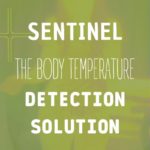
Today, the measurement of body temperature by thermal camera is a practice that tends to be democratised. Many methods exist, from the most traditional with manual solutions to the most complex integrating artificial intelligence. All these solutions have their advantages and disadvantages, but they are all sufficiently accurate to be used effectively as additional barrier measures, particularly against Covid-19.
The benefits of remote temperature sensing solutions
The main advantage of the latter is the possibility of carrying out a large number of temperature measurements remotely and completely independently. This gives people inside or outside your organisation the opportunity to reinforce the thermal camera security system that is already in place by means of everyday barrier measures.
It’s about giving your travellers, colleagues and customers the opportunity to take action for the health of all!
Obviously, this type of thermal imaging device must be accompanied by staff trained internally on the procedure to follow in the case of a positive detection of a person by the device in order to accompany them. As the measurement is done autonomously, this leaves more time for the staff to focus on follow-up and support rather than on the measurement itself.
At Motilde we offer the Sentinel solution: different ranges of remote body temperature detection solutions, easy to integrate into your spaces. For more information, contact us!
Precise measurement methods
It’s all very well to offer your customers and employees the opportunity to take their temperature on their own and remotely, but how accurate are these devices?
Many models of thermal imaging cameras for body temperature detection are now available on the market. The models range from industrial thermal imaging cameras to totem tablets for access control, with different ranges and features, but all with an accuracy between 0.2 and 0.5°C.
Is this precision significant?
And why do some more expensive products have worse accuracy than others that seem to be in a lower range?
The accuracy displayed on the commercial and technical data sheets depends on the manufacturer’s reference system. In general, the more aggressive manufacturers indicate a lower accuracy value corresponding to a minimum (or maximum accuracy offered by the device) or average value. Other manufacturers, usually the more experienced ones, prefer to communicate a maximum certified value, which implies that in 99% of the cases the accuracy will be much better than the published one.
Thus, this precision should be taken with a grain of salt and should ideally be associated with a confidence interval, unfortunately rarely published by the manufacturer and often not studied in detail. It is important to emphasise that in order to choose a good temperature detection system, it is important to analyse the components of the thermal modules and optical cameras as well as the image processing and analysis technologies used. Compliance with the installation requirements also plays an important role in the quality of the solution.
Motilde offers to accompany and assist you in your selection.
Some of these solutions also allow for other options, such as mask verification, and can be easily integrated with gantry or other systems.








